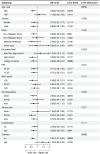Association between dietary carotenoids intake and fecal incontinence in American adults: evidence from NAHNES 2005-2010
- PMID: 39634545
- PMCID: PMC11616493
- DOI: 10.3389/fnut.2024.1486741
Association between dietary carotenoids intake and fecal incontinence in American adults: evidence from NAHNES 2005-2010
Abstract
Object: Carotenoids represent a class of bioactive compounds with potential implications for gut health. However, the relationship between dietary carotenoid intake (DCI) and fecal incontinence (FI) remains unclear. This study aims to elucidate the association between DCI and the risk of FI.
Methods: Participants aged 20 and above from the National Health and Nutrition Examination Survey (NHANES, 2005-2010) were included in the study. Data on FI were derived from the bowel health questionnaire, while DCI information was obtained from dietary interviews. Survey-weighted logistic regression analysis and restricted cubic splines (RCS) were employed to evaluate the relationship between DCI, its subtypes, and FI. Weighted quantile sum (WQS) regression was utilized to assess the overall effect of DCI and its predominant subtypes. Finally, subgroup analyses were conducted.
Result: The study included a total of 11,915 participants, of whom 1,023 (7.0%) experienced FI. Logistic regression analysis revealed that, after adjusting for all covariates, there was a significant inverse association between DCI and the risk of FI (Model 2: Q4 vs. Q1, OR = 0.67, 95% CI: 0.52-0.86, p = 0.003). However, among the DCI subtypes, only β-carotene was found to have a significant inverse relationship with FI (Model 2: Q4 vs. Q1, OR = 0.68, 95% CI: 0.52-0.88, p = 0.005). The RCS curves indicated no non-linear relationship between DCI, its subtypes, and FI (all p-non-linear >0.05). WQS analysis identified β-carotene (weight 38.2%) and lutein/zeaxanthin (weight 27.8%) as the primary contributors.
Conclusion: High levels of carotenoid intake, particularly β-carotene and lutein/zeaxanthin, are associated with a reduced risk of fecal incontinence. This discovery provides dietary recommendations for patients suffering from FI.
Keywords: NHANES; dietary carotenoids intake; fecal incontinence; lutein/zeaxanthin; β-carotene.
Copyright © 2024 Li, Wen, Cao and Cheng.
Conflict of interest statement
The authors declare that the research was conducted in the absence of any commercial or financial relationships that could be construed as a potential conflict of interest.
Figures




References
-
- Bharucha AE, Dunivan G, Goode PS, Lukacz ES, Markland AD, Matthews CA, et al. . Epidemiology, pathophysiology, and classification of fecal incontinence: state of the science summary for the National Institute of Diabetes and Digestive and Kidney Diseases (Niddk) workshop. Am J Gastroenterol. (2015) 110:127–36. doi: 10.1038/ajg.2014.396, PMID: - DOI - PMC - PubMed
LinkOut - more resources
Full Text Sources

